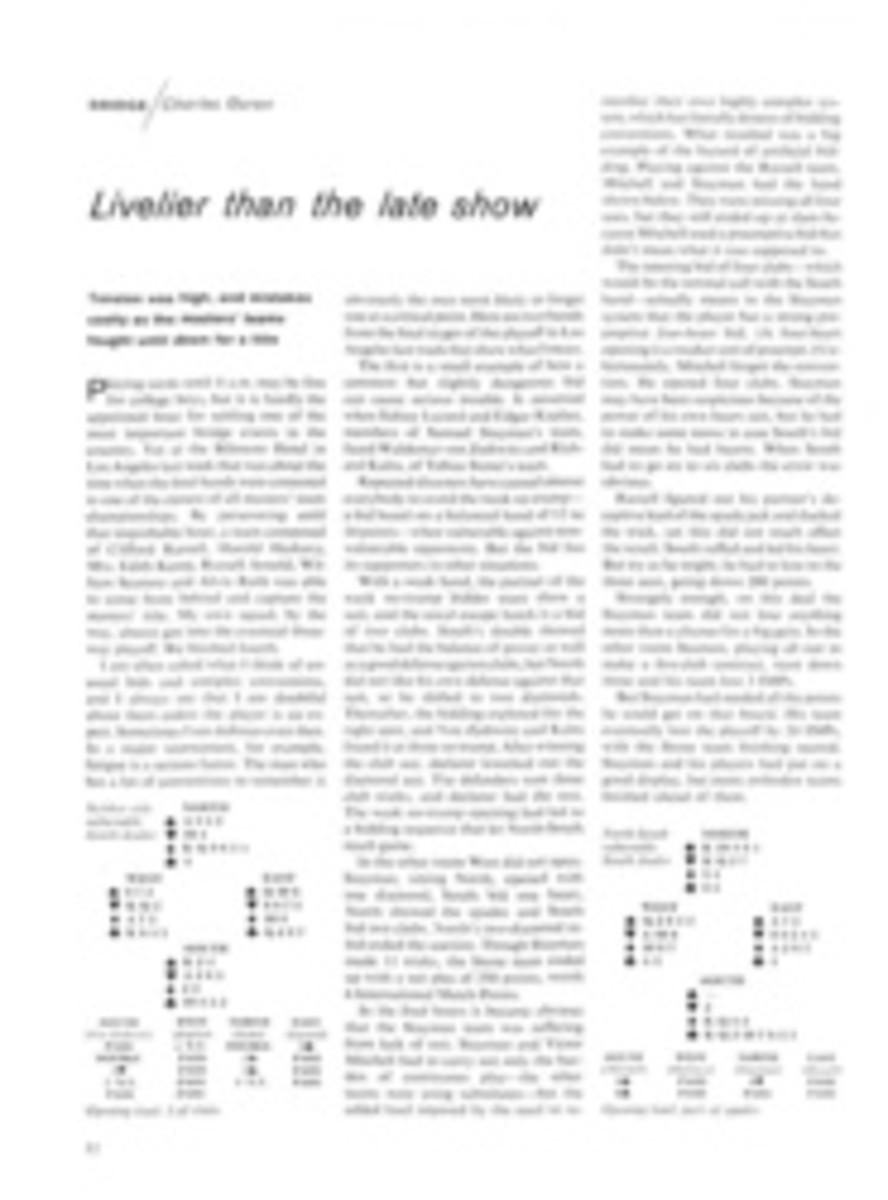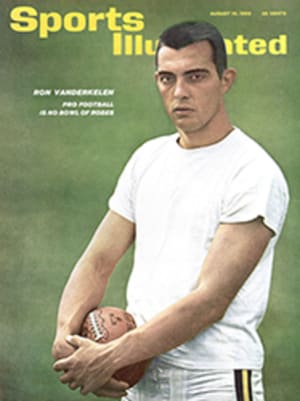
Cool run for an old hot rodder
The early morning air was still cool. Resting impressively on the vast Bonneville Salt Flats of western Utah was a missile-shaped, three-wheeled vehicle that looked like a fighter plane ready for takeoff, except that it had no wings. Near the machine, which soon was to cause international arguments as to what it really was—automobile, earthbound aircraft or motorcycle—stood Craig Breed-love, short and pleasantly youthful in a lightweight blue pullover, matching trousers and dark-blue sneakers. He was sipping ice water and trying, with only moderate success, to look casual. "Sure I'm nervous," he finally snapped at a questioner.
At 6:25 a.m., Breedlove stopped sipping the ice water ("That's all the breakfast I want now"), eyed the clear blue sky overhead and then spotted something wrong. Taking out his handkerchief, he climbed up to the cockpit of the Spirit of America, wiped a spot off the green-tinted plexiglass canopy, and stepped down. Carefully, he stuffed cotton in both ears, put on a helmet and wraparound goggles and climbed into the cockpit. Crewmen helped him fasten a yellow air mask, and Breedlove, looking like "a man from Mars in pajamas" (his own description) was ready.
In a raspy voice, L. T. (Ben) Torres, an official of the U.S. Auto Club, called out, "Zero [wind] at the south test, and she's all clear." This was the time and these were the words Breedlove had waited four years to hear. The Spirit of America inched forward, its jet engine shrieking. It gathered speed rapidly. Soon it was a speck, seemingly headed straight through the orange sun to the southeast. Then it disappeared.
Thirty-three minutes later the monster, twin parachutes billowing in its wake, came back. When it had rolled to a stop, Breedlove flipped back the canopy and hopped lightly to the ground. He had already heard that he had gone through the first measured mile—midway down the 9½-mile track—at 388.47 miles per hour. Fast, but not fast enough to break the world's land-speed record of 394.196 set by England's John Cobb in 1947.
Whether Breedlove had attained the goal he had so long sought, and toward which Shell Oil Company and Goodyear Tire and Rubber Company had spent hundreds of thousands of dollars, depended upon the speed of his return run. (In all such record attempts two runs in opposite directions are required, negating any possible wind advantage.)
Torres, pressing a set of earphones close to his head, was in touch with the timers' stand 4¼ miles away. Unsmiling, Breedlove stood silently in the middle of a small group of project officials, crewmen, reporters and photographers. His head was down, and he desultorily moved a foot around in the soft salt.
The wait and the silence were oppressive. "Craig," Breedlove was asked finally, "you said the other day you could tell how fast you were going in test runs by the way the mile markers flipped by. How did they flip on this last trip?"
"It felt like about 425," Breedlove answered.
The small circle gasped. Torres held a hand microphone up to his mouth. The timers' stand was reporting. "Repeat that," he demanded. Then: "Four twenty-eight point three seven? And the average? Four zero seven point four five!"
A new man
Craig Breedlove's taut, wind-and-sun-tanned face wrinkled into the first grin he had allowed himself all day. He embraced his crew members, project officials, newsmen and total strangers. He signed autographs, and when his wife, Lee, arrived from the timers' stand, he gave her the warmest embrace of all.
"We did it, huh?" he said, over and over. "We did it, didn't we?"
How did it feel? everyone asked. What's it like to go 400 miles an hour over the salt?
"Great!" shouted the now uninhibited Breedlove. "Great!"
"I don't think the limit has been reached yet," Breedlove declared. "I think I can go faster."
He was ready to go again then. But first, he said, someone had better help him check the chutes (the red-and-white-ribbed braking parachutes that eject when Breedlove touches a button near the steering wheel, killing the motor at the same time). "Everything went smooth except for a few crosswinds and the chutes," Breedlove said, and explained that the chutes had released prematurely. No harm this time, but he was taking no chances.
After a quick huddle with Shell officials, Breedlove decided to run the following day. Later it was announced he would be flown to New York for personal appearances instead. Shell and Goodyear had a publicity harvest to reap.
But even before Breedlove could get off the Salt Flats, the grandeur of his accomplishment was being questioned. Immediately, there were some who cited the rocket sled ride of Lieut. Colonel John Stapp, a U.S. Air Force physician who was thrust across New Mexico's flat plains at 632 mph in 1954. Stapp, however, had no control over the sled, and the sled, strictly speaking, did not ride on land. It was on a raised rail.
In Paris the Fédération Internationale de l'Automobile, with cool unconcern, said the Spirit of America was not an automobile. It referred all questions concerning recognition of the record to the Federation Internationale Motocycliste in Geneva, which seemed pleased at the sudden attention. FIM had a category for Spirit—"Cyclecar," classified as "motor vehicles with three wheels, forming three tracks and composed of an inseparable ensemble." Even so, it noted, the category was for piston engines. FIM promptly created a turbine class to accommodate Spirit.
To the world and even to Donald Campbell, this was so much nit picking. In Australia, where Campbell was completing arrangements for another try at the world land-speed record next spring in his $4-million Bluebird (SI, July 29), he said, "Jolly good effort." The fact that Breedlove's car had three wheels instead of the conventional four, and that it was driven by a jet engine that powered the machine by thrust rather than a piston engine that transmitted its power directly to the wheels, was beside the point. "I don't think this is really important," Campbell said. "Technically, yes. But, in the eyes of the world, no. If we are to succeed in beating Cobb's record with Bluebird and fail to break Breedlove's as well, then, in my mind, we will have failed."
Craig Breedlove has been chasing speed records for almost as long as he can remember. In high school at Venice, Calif. he put together his own hot rod and set seven speed records, one of which still stands. His goal even then was to go faster on land than any other human. Married at 17, he was divorced at 22, the father of three children. He speaks of that period of his life with a mixture of remorse and concern. "My wife didn't understand what this was inside me to do these things. Everybody wants to do something. People who haven't any drive never get anything done." His second marriage was to a girl who did understand this thing inside him. She was Lee, a car hop at a local drive-in, who had two children by a previous marriage and, like her new husband, a penchant for fast motorcycles. "She can ride it with the front wheel right off the road," Breedlove boasted last week.
The Breedloves' small house on Sepulveda Boulevard in West Los Angeles was soon crowded on weekends with five children, two dachshunds and numerous mechanically minded friends who managed to pick their way through a front yard crowded with afterburners, machines, tools, spare parts, a Fruehauf Trailer and the few weeds hardy enough to grow in such a jungle. Sometimes working—he was a fireman and local mechanic—sometimes on unemployment compensation, Breedlove always was able to scrape together just enough money to keep his project going.
Conversion at Sepulveda
The Breedloves learned to live with two air duct molds 10 feet long and weighing 1,000 pounds lying on the living room floor. Breedlove jacked up the rear wall of his garage, moved it back 21 feet and extended the roof to cover it. The garage now measures 41 feet by 20 feet and makes the attached five-room house look like an appendage. Friends with the same enthusiasm as Breedlove's came to help. Rod Shapel, an automotive designer and project engineer at Task Corp., drew up the first blueprints. Art Russell, a model builder for Revell, carved a model out of pine to be used in wind-tunnel tests. Walt Sheehan, a Lockheed designer, concocted the air ducts that lead from the nose to the rear section and feed air to the jet engine. The original engine itself came from Ed Perkins, a Los Angeles machine shop owner (and a bishop in the Mormon church).
Breedlove tried many times to interest major companies in the Spirit, but until last year he had no success. Then Shell, rarely active in competitive U.S. motor circles, indicated it would be interested if Breedlove could get a tire company to go along. After extended delays, Goodyear agreed to design and build 48-inch tires, machine the wheels and make the brakes, parts that are so interrelated they cannot be made separately. "It was like they took the world off my back," Breedlove said.
Breedlove had estimated that Spirit would cost $30,000 before it was ready for Bonneville. "That seemed like all the money in the world. At the rate we had been going we thought we could build three cars for the price. But I spent the $30,000, and I hadn't even got out of the garage."
The first engine developed problems, so Shell bought two more—General Electric J47 jets similar to those used in F-86D fighter planes. The first forging of the rear axle was out of tolerance and the cost for that jumped from $300 to $3,000. While the neighbors watched in alarm, the car grew to look like an ICBM at Cape Canaveral. It became 35 feet long and 11 feet wide, and its weight reached three tons. The cost grew, too—the total was about $250,000. "It was handmade," says Breedlove, "but I mean made with hand tools, a little file and a screwdriver. The car is the equivalent of a prototype fighter plane that would take an aircraft company a million dollars, 20,000 men and all their machinery to build."
Breedlove has been persuaded that he can gain nothing by bettering his mark now. He will run next year, but if his mark should be surpassed this summer, he can go back to the Flats within 48 hours. One challenger, Dr. Nathan Ostich of Los Angeles, has a chance. He will be at Bonneville with his jet-powered Flying Caduceus for the fourth time, beginning on September 22. Last year the Canadian-born physician had worked up to 331 mph before spinning out and narrowly escaping death on his 13th run.
Breedlove is not particularly concerned about competition. He believes the Spirit of America has untapped speed in her. "We didn't even have the filter screen off the engine intake," he said last week. "The tires (which have tested at 624 mph) were still cool." The engine ran at 95% of efficiency, but with an afterburner it could run considerably above the critical drag number of the car, 550 mph, beyond which the car resists acceleration.
Something less, however, will content Breedlove. "It's easy to talk speed," he says. "Say, 600 mph. It's easy to add another 100 mph to that. But you're talking about going too fast. Who knows what will happen when a car goes through the sound barrier? In a plane the shock waves dissipate. In a car they fly off and hit the ground. They may bounce back and damage the car. They certainly won't do the track any good. Six hundred is pretty fast. It's not practical." But 500 or a bit more might be. Craig Breedlove, a cool hot rodder, is ready, if necessary, to find out.
PHOTO

